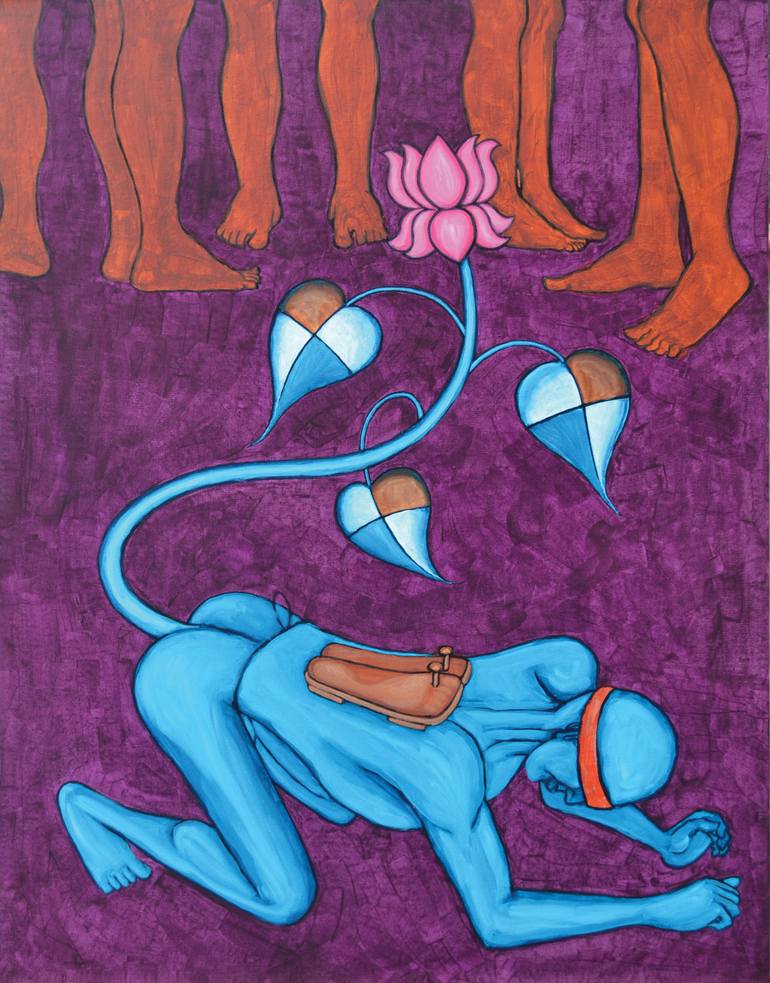


VIEW IN MY ROOM
Glorified Slavery - 2 Painting
India
Painting, Acrylic on Canvas
Size: 28 W x 35.8 H x 0.4 D in
Ships in a Box
About The Artwork
This is one of the famous paintings of T Murali, which answers the question on how and why a slave finds a place at the feet of the lord of the Nagas - Shiva- motivates this painting. This painting also investigates how slavery is romanticized as an achievement of nirvana (enlightment). Till the 5th century of CE the majority of Indian people were Buddhist or Jain and there were no discrimination between citizens based on cast or creed. But after the 5th century Buddhism started to decline and brahmin priests/witches becomes influential power in the society. The cast system or Chathurvarnya was slowly imposed on people as official spirituality of rulers and a way of life. The Sanskrit language was introduced among scholars as the divine language of gods. It caused culturally rich local languages to lose their glory and dignity before scholar's official language, Sanskrit. The Buddhist monks and scholars were labeled as Non-believers, Asuras, Rakshasas, Nagas and were brutally killed. So, the Buddhist people lost their spiritual leaders and light houses of knowledge. Brahmanism mainly depend on the lower cast people called Sudras who were adopted from the tribal people of old India. Sudras were the servant class or Slave cast of chathurvarny system implemented by Brahmanism. The Sudras were not allowed to learn any kind of knowledge or even an alphabet of their Mother-tongue. If a sudhra hear accidentally a piece of knowledge from some ones mouth, he would have lost his hearing organs by pouring melted lead in both ears as punishment as per the Brahmanic law, Manu-smruthi. This kind of inhuman laws made sudras as mere living instruments or goons or slaves to annihilate or enslave the Buddhist followers by brutal ways. And the sudra women were also slaves and they were utilized as professional prostitutes by cross breading with other casts mainly brahmins. This kind of total submission before brahmin cast made sudras very trust worthy and Sudhras were posted as puppet kings under brahmanic controlled regions. As slaves became the puppet kings or local rulers, they were advised to make remaining buddhist people poor by exploiting through heavy taxes, and suppressing them to a new folder of slave class or Avarnas. The other backward classes and dalits of Indian population were formed thus. When knowledge and reason sprout as a thousand petals of a lotus in buddhism, the brahmanical religion thrives on exploitation, slavery, and sexual anarchy. It is not even a religion. No one have founded a religion called Hinduism. But it was came to existence in 1871 when the British empire conducted the first census of India, by naming the majority people of India as Hindu religion believers. So, this painting portrays the glorified slavery system as an artist's commitment to address the present cast based society by an in-depth study of social history of India.
Details & Dimensions
Painting:Acrylic on Canvas
Original:One-of-a-kind Artwork
Size:28 W x 35.8 H x 0.4 D in
Frame:Brown
Ready to Hang:Not applicable
Packaging:Ships in a Box
Shipping & Returns
Delivery Time:Typically 5-7 business days for domestic shipments, 10-14 business days for international shipments.
Handling:Ships in a box. Artists are responsible for packaging and adhering to Saatchi Art’s packaging guidelines.
Ships From:India.
Customs:Shipments from India may experience delays due to country's regulations for exporting valuable artworks.
Have additional questions?
Please visit our help section or contact us.
India
T Murali is a whole time painter. He had done more than eghteen solo exhibitions of paintings in the last three years. And He is an author of an art book - "AMANA" , acollection of thirty five paintings and descriptions in Malayalam language, which was published in March, 2016. Artist T Murali's works explore the trajectory of hegemonic material violence in the tumultuous contexts of the cultural history and social formations in Kerala. He has painted the historic moments of subaltern revolt and resistance in south Travancore as in Channar Woman and also vividly depicted the mutilations and genocidal violence done on the body and bio power of the Avarna woman in Kerala by casteist patriarchy for almost a thousand years in the establishment of the Hindu Brahmanical cast system and its feudal patriarchal order here. His works also make visible the repressive violence and representational dilemmas involved in the traditionalist and elitist iconography of our prevalent world view and common sense. A scathing critique of popular religion and dogmatic faith in metaphysical and obscurantist discourses of the dominant order is also evident and visible in Murali's vivid visual idiom. The artist engage seriously with the contemporary idiom of visual arts and try to represent the struggle for a new visual language and expression from within the realm of the sign and the visual codes of local culture. In this sense the works are contemporary and vernacular at the same time. Contemporary in the sense of the themes and socio political issues presented and vernacular in the nuances of cultural location and signification. Through the depiction of the local and the vernacular he also trys to resist the Meta Narratives of the Nation and the hegemonic and oppressive cultural logic of the Nation State in particular. By foregrounding the human and the ethical within the minor and other these works resist the reinstatement and deification of local cultural elitism and neo Nationalisms or dominant religious revivalisms of the regional sort.
Thousands Of Five-Star Reviews
We deliver world-class customer service to all of our art buyers.
Global Selection
Explore an unparalleled artwork selection by artists from around the world.
Satisfaction Guaranteed
Our 14-day satisfaction guarantee allows you to buy with confidence.
Support An Artist With Every Purchase
We pay our artists more on every sale than other galleries.
Need More Help?